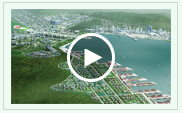|

Investment environment in Rason Economic and Trade Zone
Nature and geography
Natural resources and infrastructures
Legal groundwork and economy
Finance, education and culture
Investment Projects
Projects for Development of Industrial Parks
Projects for Development of Tourist Destinations
Investment Projects for Local Industries
Investment Items
Investment Policy
Tax Policy
Procedures of Enterprise Establishment
Management Committee of Rason Economic and Trade Zone |
Investment environment in Rason Economic and Trade Zone
>> Natural resources and infrastructures
Deposited in and around the Zone are peat, coal, aluminium, crystal and other kinds of underground resources.
The Zone is rich in marine resources, including sea urchin, sea cucumber, squid, seaweed, crabs, shellfishes and other delicious fishes, and such agricultural products as Songi mushroom (Armillaria edodes) and bracken.
It also boasts of several tourist destinations such as unique scenic spots, fascinating bathing resorts, natural monuments including Uam Seal Habitat and Alsom Seabird Reserve and Chonghak Mineral Spring Resort.
The Zone has no other large rivers but the Tuman River.
There are more than 10 streams, including Rajin, Huchang, Sonbong, Kwangok and Ungsang, and several lakes such as Manpho, Sobonpho, Tongbonpho and Ryongsu.
There are the Sonbong Thermal Power Plant with generating capacity of 200 000 kW, the Rason Youth Power Plant and the Uam Wind Farm.
In the future it is planned to increase the generating capacity of the Sonbong Thermal Power Plant, build a new coal-fired power plant with generating capacity of 600 000 kW and widely tap wind, solar, hydraulic and other natural energy resources in meeting the demand for power supply in the Zone.
The Northeast Asia Communications Company, established as a joint venture with the Thai LoxPac Co., Ltd. in 1996, deals with domestic and international telecommunications service in the Zone by introducing advanced systems.
It plans to link the existing optical fibre cables to all the branch offices in the residential quarters and districts to be newly built in the future, and bury all the communication lines under the ground or in underground ducts.
In order to improve the drinking water supply system, it is planned to reinforce the existing Rason Reservoir and build more reservoirs so as to increase water storage capacity up to 720 000 cubic metres.
Meanwhile, it is planned to introduce a comprehensive sewage purifying system in the residential quarters and the industrial parks.
  
   
|
